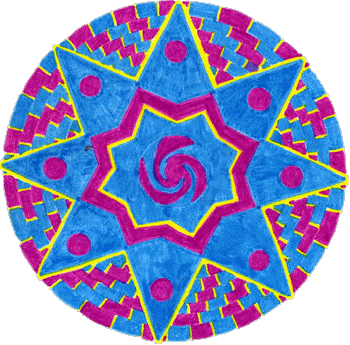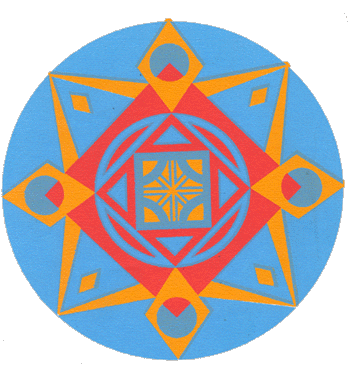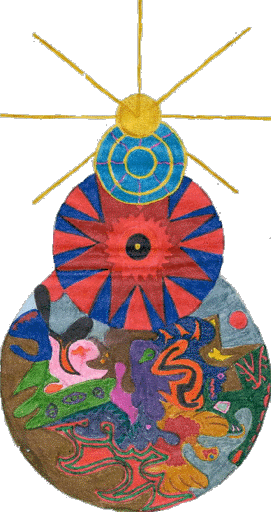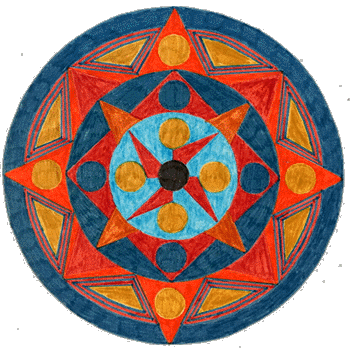|
|
|
|
 |
 |
| Share your thoughts. |
 |
||||||
|
||||||
MANDALA SYMBOLISM REFLECTIONS Do you carry photos of family or friends in your wallet or purse? Do you have them displayed in your office or home? Have you ever wondered why? Busy as we are most of the time, focused on the coping patterns and survival subroutines of daily living, pictures help us remember who we love and how we feel in their presence. They give us a sense of rootedness and connection, help us feel supported in times of uncertainty or distress, inspire us to acts of generosity and good will and help us keep our values clear. What about mirrors? How often do you pause in front of a mirror to see if your tie is straight, if your hair is where it belongs, or if your makeup is well applied? You catch a peek as you get ready to confront the social world and, secure in the knowledge that you've done the best you can with what you've got, you charge off to face the day. Photographs and mirrors give us reflections of what ordinarily remains outside our awareness or field of view. They help us stay connected to loved ones, and to ourselves. Mandala art operates in a similar manner but, instead of giving us reflections of the external world, mandalas can help us see what is going on within us, in our heart and soul. They can help us remain connected to our Selves in fundamental ways and can help us understand the meaning of important life experiences when we learn how to create and interpret them. BACKGROUND
Mandala means 'circle' in the Sanskrit language, and mandala art refers to symbols that are drawn, sketched or painted in a circular frame. Mandala art has been used throughout the world as a process of self-expression, in the service of personal growth and spiritual transformation. Tibetan Buddhism has employed mandala art for thousands of years to capture the images of the countless demons and gods which it believes both plague and uplift humanity. Navajo sand painters use them in their healing rites. Many native people use the Medicine Wheel, a mandala form, to connect to earth energies and the wisdom of nature. The very fact that mandalas are drawn round can lead us to an experience of wholeness when we take the time to make them and then wonder what they mean. In the strict use of the mandala, there is a central point or focus within the symbol from which radiates a symmetrical design. This suggests there is a center within each one of us to which everything is related, by which everything is ordered, and which is itself a source of energy and power. Virtually every spiritual and religious system known to man asserts the reality of such an inner center. The Romans worshiped it as the genius within. The Greeks called it the inner daemon. Christian religions speak about the soul and the Christ within. In psychology we speak of the Higher Self. SYMBOLIC DIMENSION How do we begin to connect to this inner center? We need to learn how to work with imagination to see into the inner self. But when we begin to play with images and symbols, we move from a cognitive, rational, intellectual and narrow frame of reference and enter an expanded state of awareness. One of the primary functions of imagination is to help us see how our inner energies are operating, all at once, in a way the rational mind cannot perceive. Within each of us are a multitude of drives and desires, hopes and fears, wounds and latent abilities that need to be acknowledged and consciously dealt with if we hope to continue to grow as human beings, learn from our experiences, and move toward the synthesis of our biological, personal and spiritual potentials.
We cannot see into the unconscious directly, however, and so we need some kind of mirror with which to see the dynamic forces that operate within us. Mandala art provides such a mirror. Where once we might have experienced ourselves as a fragmented collection of subpersonalities and warring elements in opposition to one another (father-vs-professional, for instance, body-vs-mind, emotions-vs-reason, sexuality-vs-spirituality, etc.), through mandala art we can see how these parts fit complementarily together in the wholeness we truly are within. This is a critical point of view, and when we begin to take all of ourselves into account, when we begin to honor and balance the dynamic forces within us, we can act in the world in ways that honor our essential wholeness, get our needs met, and allow us to share with others the very best within us. PSYCHOSYNTHESIS Psychosynthesis is a psychological and educational approach to human development first articulated by the Italian psychoanalyst Roberto Assagioli (1888-1974). Offering both a conceptual model for understanding how we can heal, develop, and transform consciousness and practical tools to achieve these goals, Psychosynthesis refers to a process directed toward the integration and harmonious expression of the totality of human nature--physical, emotional, mental and spiritual. One of the fundamental concepts in Psychosynthesis states that the human unconscious can be understood to involve three levels, and mandala art can help both explore and document discoveries made on these three levels.
A simple description suggests that the lower unconscious represents the past and in it is stored those experiences, memories, elements and dynamics that remain repressed or unresolved. The middle unconscious represents the present, and in it is stored all information, patterns, and dynamic energies functioning in the current stage in life. The higher unconscious represents the future and can be thought to contain all the unutilized talents and potentials waiting to be developed. The concept of the Higher Self expresses the presence of an inner guiding principle, the genius within, the divine spark to which the "I" aligns in cooperation with the unfolding and evolutionary process. Practitioners of Psychosynthesis to assist individuals and groups in the soul-work of transformations of consciousness so that they can align with the guidance and inspiration of this Higher Self and thus find the energy and wisdom necessary to understand more deeply, work more creatively, love more authentically, and successfully meet the challenges which confront us at each stage in life. HOW TO CREATE A MANDALA There are many ways to create a mandala, but first we must lightly draw a circle on a sheet of paper or on a canvas. We can fill the circle in spontaneously, letting the drawing emerge step by step in a creatively unpredictable way, like doodling. Or, we can fill in the circle with special images that have come to us in deep relaxation, meditation, through the use of visualization techniques, etc. Within the circle we can capture important scenes from everyday life, or objects of fascination from the world of nature. Filling the circle in is the first step. Mandala art is a tool of integration for many reasons. The creation of these symbols involves many parts of us. Our body is involved in the mechanical act of drawing, and we experience our own nervous system in a new way in the fine movements required by the act of drawing. Our mental patterns are reflected in the specific forms and structures that emerge within the circle. Our feelings are reflected by our use of color. When the mandala is complete, we have an interesting, often beautifully wholistic snapshot of what is going on within us and of our present reality. We can then look at the symbol with curiosity and wonder, figure out what the structures, colors, and interacting elements mean and thereby gain an expanded view of how our lives are working. THE VALUE OF MANDALA ART What is the value of mandala artwork? First of all, by drawing these symbols, we shift our attention from external preoccupations and concerns and connect to our own inner space. This inward attunement is often quite relaxing, refreshing, and energizing. Second, mandala art is a private process of self-confrontation and self-expression for which we need not depend on a guide or therapist or outside consultant. In the search for the meaning of our experiences in life, we can sit down anytime we want to, draw a circle, fill it in, capture a reflection of what is going on inside and figure out what it means. Third, through the mandala we can discover where our energies are blocked, where our resistance lies, in what roles and patterns we are stuck. Or, in compelling and graphic ways, we can celebrate our successes, portray the things which have inspired or touched us in life and, in this way, learn the most from them. Fourth, mandala art can help us connect to, accept, love and learn from the very center of ourselves, the Higher Self so to speak, which struggles to live ever more freely and creatively in the world. One of the greatest challenges in life is to discover and nourish the deep springs of inner wisdom that flow within us, and spending time with mandala art encourages our inner genius to awaken, communicate, and express itself directly. Fifth, mandalas can help us see the larger cycles that operate in our lives if we do them regularly, then review a series of drawings that have developed over time. Last, mandalas are powerful images to share with others. Through them we can share our inner realities with family and friends in honest and open ways, whenever we choose, and by this encourage our loved ones to share with us their depths as well. We need to find ways to connect to our inner depths, to heal our wounds, and nurture the growth of new potential within us. Mandala art is one of the most creative, direct, and transformative ways to accomplish these important goals.
REFERENCES Arguelles, J. & Arguelles, M. (1995). Mandala. Boston: Shambhala Publications. Brauen, M. (1997). The mandala: Sacred circle in Tibetan Buddhism. Boston: Shambhala Publications. Cornell, J. (1994). Mandala. Wheaton, IL: The Theosophical Publishing House Fincher, S. F. (2000). Coloring mandalas: For insight, healing and self-expression. Boston: Shambhala Publications. Jung, C. (1972). Mandala symbolism. R. F. C. Hull, trans. Princeton, NJ: University Press. Tucci, G. (1970). The theory and practice of the mandala, Alan Houghton Brodrick, trans. New York: Samuel Weiser, Inc.
Michael began creating mandala art while in training in LSD psychotherapy at the Maryland Psychiatric Research Center in Catonsville, MD, in 1973. Since that time he has drawn more than 2000, including the four featured in this article. Michael regularly conducts seminars, workshops, and retreats on how to use mandala art as a tool for transforming consciousness, and uses it with all his counseling clients as one of a dozen "Techniques for Better Living." For a complete catalogue of mandala related web sites on the Internet, go to: http://www.abgoodwin.com/mandala/
|
||||||
|
||||||
|



